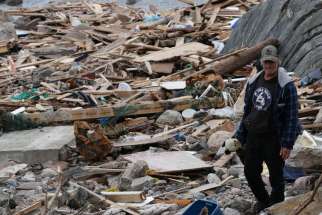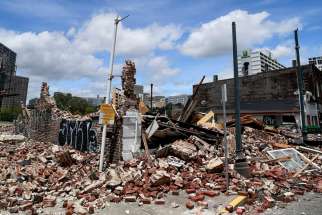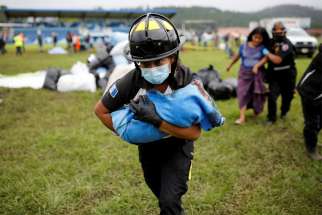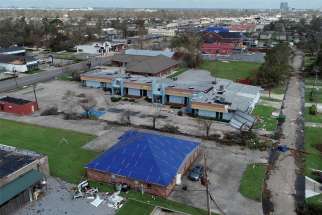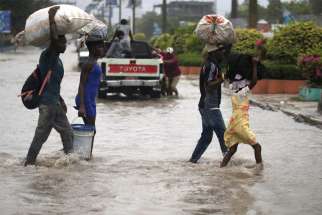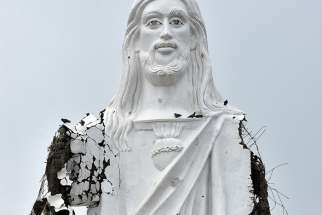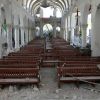The morning after Hurricane Otis stormed through Acapulco as a Category 5 monster, Father Leonardo Morales surveyed the damage and saw total destruction.
Churches appear to have escaped Fiona’s wrath
Damage inflicted to church properties throughout the Maritimes by post-tropical storm Fiona has yet to be tabulated, but it seems for the most part Catholic Church property has escaped relatively unscathed after one of the strongest weather systems to ever hit Atlantic Canada.
New Orleans Archdiocese assesses damage from Hurricane Ida
NEW ORLEANS -- With most of South Louisiana cut off from electrical power due to the 150-mph winds of Hurricane Ida, the Archdiocese of New Orleans announced Aug. 30 that all schools, along with its main administrative offices, would remain closed until at least Labor Day, Sept. 6.
MEXICO CITY -- Pope Francis offered prayers for the victims of Hurricane Eta, which deluged Central America, claimed at least 50 lives and caused widespread flooding and property damage.
LAKE CHARLES, La. -- Hurricane Laura destroyed six churches in the Diocese of Lake Charles, left a dozen others "highly compromised" and did heavy damage to chancery offices.
CLEVELAND -- Officials reported that at least 12 people had died as Tropical Storm Laura lashed Haiti and the Dominican Republic with strong winds and torrential rains, causing widespread flooding in low-lying communities.
Catholic organizations provide aid in Florida for Dorian victims
MIAMI -- In the wake of Hurricane Dorian's brutal blasting of the Bahamas, Catholic organizations in Florida continued to raise funds to aid victims there.
New Orleans Archdiocese: Forever changed by Hurricane Katrina
NEW ORLEANS - They are calling it "Kat 10" — Hurricane Katrina plus 10 years — which carries with it the double meaning of an ominous meteorological warning.
People lost ‘stuff,’ but have each other
ISLAND PARK, N.Y. - Sacred Heart Church in Island Park is in an area of the diocese of Rockville Centre among the most devastated by Hurricane Sandy, but the pastor urged parishioners not to fret about the material goods they have lost.
“Don’t be angry. We lost stuff. We will get other stuff,” Msgr. John Tutone, pastor, told the congregation during his homily at Sunday Mass Nov. 4. “We still have each other and the people we love. That’s the most important thing.
“There are people on your block that need you. Knock on their doors and offer your help. We have to maintain our souls. We have to maintain ourselves by helping others.”
In the community of 10,000 people in the southwest corner of Nassau County, Long Island, 80 per cent of the homes were flooded. The church, too, was flooded. A metre of water was pumped out of the parish centre, which is now being used for Masses.
As of Nov. 5, the death toll from Sandy was at least 106 in the United States, two in Canada and 67 in the Caribbean. The Associated Press reported that about 1.4 million people were still without power, down from a peak of 8.5 million. Of those, about 800,000 were in New Jersey, down from 2.7 million, and about 530,000 in New York, down from 2.2 million.
Early damage estimates put Sandy’s cost in the range of $30 billion to $50 billion.
St. Ignatius Martyr is a sturdy 88-year-old brick church that sits a block from the ocean. Sandy caused minimal damage to the church, though the rectory basement was flooded to the ceiling. Nearly 200 people gathered in the cold, dark church for the 10 a.m. Sunday Mass Nov. 4, celebrated by Msgr. Donald Beckmann.
Chris and Dawn Hagen attended with their children. Going to Mass “was important to restore some routine to our lives. We wanted to be with other people in a place that gives us comfort,” Chris said. “It’s good to come together and pray with people. It’s comforting to see our church is here and we can worship.”
“We’re grateful we are alive and have each other,” said Dawn. “We’re praying for our friends and our family and our own recovery.”
Beckmann described his most important tasks after Sandy: “One is to continue the sharing of the sacraments and preaching the Gospel in as normal a way as possible. ... A couple of people said to me, ‘It’s nice to come back here and see things as normal as possible.’ To see the church functioning is important to them. ... The second thing is to do whatever the church can do to help the wider Long Beach community.”
He said he was “praying a prayer of thanksgiving for all who have survived. I’m also asking the Holy Spirit to show us the proper way to move forward, our three parishes, the whole community and other religious institutions.”
SANTO DOMINGO, Dominican Republic
On the little islands that make up the Caribbean's Lesser Antilles, there is not much in the way of protection from the annual wrath of the Atlantic hurricane season. Every year from hurricane season's start on June 1 until the end of peak months — August through October — the islands are like sitting ducks.
It's a threat that Marcia Boxhill-Haywood, regional co-ordinator for Caritas Antilles, confronts with meagre tools: a $40,000 emergency fund, a small staff that mans a warehouse in St. Lucia and a handful of volunteers.
Responding to hurricanes "goes right to the heart of what the Church does because storms don't just destroy buildings, they really destroy families and communities," Boxhill-Haywood said. "In these emergencies, the Church caters to everyone that's in need, not just Catholics. We serve all denominations."
Catholic dioceses across the Caribbean, Central America and Mexico are on the frontline during hurricane season. They shelter residents during storms and serve as first responders after they have passed, handing out food, water and medicine and helping residents rebuild their lives.
Yet, preparing for the potential damage to church buildings and the financial strain of feeding mouths and housing displaced residents remains a challenge. With funds in short supply, Catholic leaders said they co-ordinate more closely with governments and other institutions and rely on volunteers and neighbouring dioceses to fill gaps.
"It's difficult because there is a lack of resources and a lack of staff," Boxhill-Haywood said. "Putting funds into preparation for hurricanes is not on the front burner."
The Caribbean basin is in the midst of an extended period of increased hurricane activity that began in 1995 and can last for several decades, according to the U.S. National Oceanic and Atmospheric Administration. Through September of this year, the Atlantic had produced 14 named storms, eight of which were hurricanes with only one being a major storm — Category 3 or greater. Yet 68 deaths were attributed to the storms and damages totaled more than $2 billion.
Climatologists predict the situation will only worsen.
"The majority (of climate models) show an increase in high category hurricanes and a decided increase in hurricane-related rainfall, a source of flooding in ... the region," Kerry A. Emanuel, a professor of atmospheric science at the Massachusetts Institute of Technology, told Catholic News Service in an e-mail.
The region woke up to the reality of an increasingly volatile hurricane season in 1998, when Hurricane Mitch lingered over much of Central America for nearly a week, dropping unprecedented amounts of rain that set off major flooding, killing thousands and causing billions in damage. By the time the storm turned back toward the Gulf of Mexico, eventually striking Florida, it had caused nearly 11,000 deaths.
Church leaders said the region has made strides since Mitch in preparing for disastrous hurricanes and tropical storms.
However, in Central America, where the majority is poor, dioceses often find themselves shorthanded when a disaster strikes. Deep in Nicaragua's Mosquito Coast, Bishop Paul Schmitz Simon of Bluefields worries about the effects of hurricanes every year. Yet, his diocese, roughly 60,000 square kilometres, has no money set aside for the next storm.
"We don't have the resources to put some money away for a hurricane," he said. "We rely on other organizations and on our relationship with the government."
Schmitz's approach underscores the reality in which many dioceses find themselves: Short on cash to devote to hurricane preparedness, they count on other institutions and volunteers.
It's a system Schmitz has honed since Hurricane Joan hit the coast as a powerful category 4 storm Oct. 22, 1998. It killed 148 people before leaving the Central American country as a weakened tropical storm.
Schmitz said the region is about 50 per cent better prepared today than it was when Hurricane Joan hit.
Despite the lessons learned, in 2007 Hurricane Felix destroyed homes and flooded farmland. It destroyed most of the rural coastal town of Puerto Cabezas.
"I would like to say that we learned from it," Schmitz said. "We started building from concrete block and using building methods that can withstand hurricanes."
Constructing buildings to sustain the impact of hurricanes, however, is more costly and time consuming than the methods many have used for years.
In Haiti, a program to reconstruct church buildings destroyed by the January 2010 earthquake only recently doled out its first grants. The PROCHE, or Partnership for Church Reconstruction in Haiti, process requires new buildings to meet modern standards, designed to withstand earthquakes and hurricanes.
Rebuilding "intelligently and safely" is of the utmost importance, Archbishop Thomas G. Wenski of Miami said June 3 near the conclusion of a conference on rebuilding Haiti.
It was a lesson Fr. Sean Doggett on the small Caribbean island of Grenada learned firsthand. On Sept. 7, 2004, Hurricane Ivan hit the island as a Category 3 storm, damaging 95 per cent of buildings in some areas.
"In the parish where I am, there was not a house without a roof that needed at least to be repaired. Two of the (four) churches needed to be totally demolished and rebuilt, and a third needed a new roof," said Doggett of the Our Lady Help of Christians parish in Beaulieu, Grenada.
The storm was devastating, but help quickly poured in from the government, international donors and, more immediately, from neighbouring islands.
Doggett said volunteers were key links in properly distributing aid.
"I can boast that for the first month or two, the Church was much better at distributing (aid) than the government or other groups," thanks in part to the volunteer network, he said.
Today, the parish and island are far better prepared to withstand and respond to a hurricane, Doggett said.
"There is generally much more awareness of hurricanes and more information on how to prepare," he said.
In terms of construction, "there was a lot of consideration put into the standards after Ivan," he said. "The new standards require things like the use of hurricane straps and reinforcements ... for all buildings, from the smallest on up."



